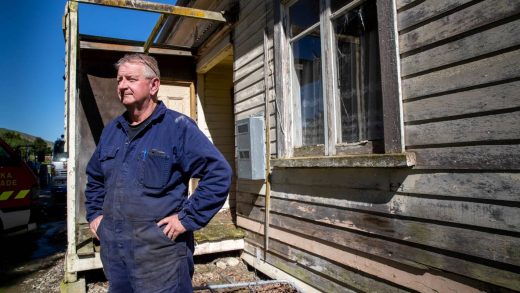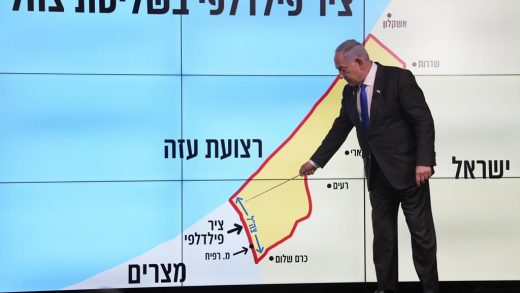
Matthew Dallas/Stuff
RSA president Captain Barrie Law addressing the small crowd who gathered to acknowledge the 100th anniversary of the Soldiers’ Memorial’s unveiling.
With wings outstretched and sword held high, her watch endures into a second century.
The Figure of Victory and the Feilding Soldier’s Memorial, a poignant scene of remembrance and unity in the town each Anzac Day, was itself the focus of a ceremony on Tuesday, marking 100 years since the monument was unveiled to the public.
Feilding RSA president Captain Barrie Law, who led the small morning service, said the crowd who gathered on October 3, 1923, to study the names of local soldiers killed in the First World War, could not have fathomed there would be a need to add further names so soon from a second world war.
He said the 100th commemoration was a way to acknowledge both the purpose of the memorial and its enduring presence in the heart of the town in Manchester Square.
Feilding man Ian Wightman, who had served in the air force for 21 years, had researched its history, poring over newspaper clippings, letters and old records.
He said the town had been slow to respond to the call from Minister of Defence Sir James Allen in 1918 for the construction of memorials throughout the country to honour fallen soldiers.
Feilding & District Heritage
The unveiling of the Feilding Soldiers’ Memorial on October 3, 1923, led by Governor General Viscount Jellicoe, right, dressed in British naval uniform.
Two attempts by the borough council to have a memorial paid for through rates increases were rejected before a third campaign, promoted by a civic committee, was launched in 1921 for a memorial paid for through public subscriptions.
Donations were solicited door-to-door while residents were surveyed on a favoured location.
“The name of every person who gave money, down to some kids who gave one penny, they’re all recorded,” Wightman said.
The town square won out over Kowhai Park, which at the time was outside the borough’s boundary.
A Sicilian marble statue was ordered from a Sydney supplier, at a cost of £600, for The Figure of Victory, while a tender of £1250 was accepted from W. E. Jones to construct the plinth and erect the statue.
Warwick Smith/Stuff
“100 years of looking over us” – The Figure of Victory stands above a Feilding Anzac Day dawn service.
The work was on track to be completed in time for Anzac Day, 1923, but The Figure of Victory was delayed due to a crack in the statue.
Once it arrived, it was decided she should face west towards Manchester Street as that’s where departing troops assembled and were farewelled.
Wightman said there had been talk in recent years of parents having to pay to have their sons’ names on the memorial but he found this to be untrue – a myth fostered by the call for donations.
During his address, Law noted that many people felt there was no need for such memorials. For him, it was important to formally remember and honour the service of both his grandfathers, his father and other relatives who served.
“Memorials do not celebrate war, they simply provide us a place, even today, a place to remember.
“A memorial allows us all to remember in our own way and for our own reasons.”
Matthew Dallas/Stuff
Members of the public were invited to lay poppies on the memorial’s hedge.
Royal New Zealand Air Force chaplain Samuel Schuurman said the Figure of Victory preserved the Feilding Soldier’s Memorial just as the community preserved the memory of the lives lost.
Law said the RSA had plans to install graphite plaques at the bottom of the plinth to acknowledge more recent conflicts, such as Somalia, the Persian Gulf, Bosnia, and Southeast Asia, while respecting the intention and integrity of the original memorial.
“For us, there’s a lot of people we’ve served with and lost, our mates, but there’s nowhere to go and commemorate.”


